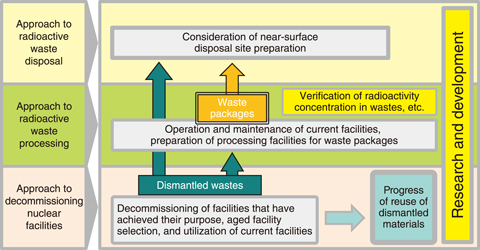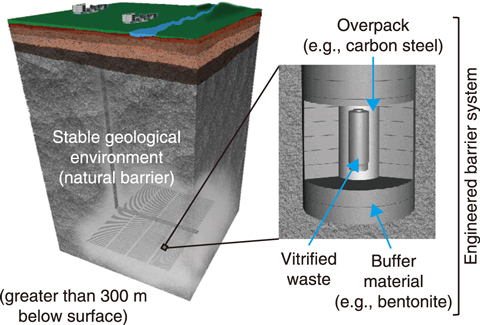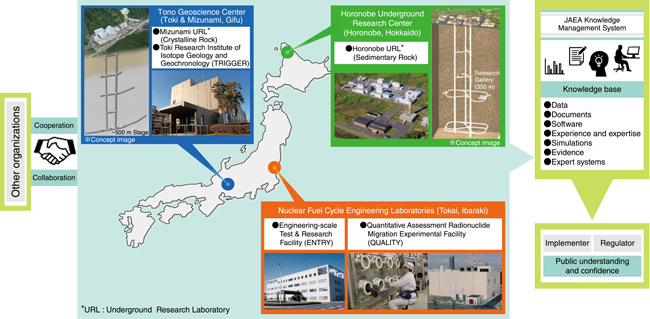
Fig.8-1 Outline of low-level radioactive waste management

Fig.8-2 Schematic view of the basic concept for the geological disposal of high-level radioactive waste in Japan

Fig.8-3 Structure of JAEA R&D activities
Toward Decommissioning Nuclear Facilities and Managing Radioactive Waste
To maintain and develop its research and development (R&D) capabilities by strengthening the safety of its nuclear facilities and ensure steady implementation of back-end measures, JAEA issues the “Medium- and Long-Term Management Plan of our Facilities” (issued on April 1, 2017, amended on April 1, 2020) as a comprehensive plan detailing the following three points:
• the selection and consolidation of facilities,
• safety measures, and
• the management of back-end issues.
In the plan, 89 nuclear facilities were chosen to be decommissioned.
Among the large facilities, JAEA submitted an application for permission to proceed with the decommissioning of MONJU and the Tokai Reprocessing Plant (TRP) to the Nuclear Regulation Authority (NRA), which led to the NRA granting permission for the decommissioning of MONJU on March 28, 2018, and for that of TRP on June 13, 2018. The application to the NRA for permission of the decommissioning of the Uranium Enrichment Demonstration Plant is ongoing.
The implementation of back-end measures requires long-term prospects and policies, including those regarding the processing and disposal of radioactive waste; the decommissioning of TRP has been expected to take approximately 70 years to complete. JAEA therefore published a long-term prospect and policy for back-end measures, the “Back-end Roadmap”, on December 26, 2018.
To ensure safe and appropriate nuclear facility decommissioning and radioactive waste management, it is necessary to introduce new technologies and knowledge and to promote the development of technologies for advanced safety and cost reduction. Technologies for the safe and effective dismantling of nuclear facilities, the minimization and stabilization of radioactive wastes, and the disposal of radioactive wastes are under development (Fig.8-1). The proposed disposal project applies to low-level radioactive wastes from research facilities of universities, private organizations, and JAEA facilities.
Specifically, this year saw a making of the calculation cord manual for the dismantling cost of nuclear facilities (Topic 8-1), an investigation of the evaluation method of the radioactivity concentration in radioactive waste (Topic 8-2), an evaluation of the influence of a low dose of radiation on the human body using machine learning (Topic 8-3), and the development of a safe disposal technology of radioactive liquid waste containing various chemical substances (Topic 8-4).
R&D to Improve Technology and Reliability of Geological Disposal in Japan
Geological disposal is internationally recognized as the most appropriate method for the long-term isolation of high-level radioactive waste (HLW), which is produced during the generation of nuclear power, from human environments. This critical issue must be approached sensibly by the present generation and will remain crucial regardless of any revision of the national nuclear energy policy.
In Japan, fuel spent in nuclear reactors is reprocessed to extract the reusable uranium and plutonium for power generation. The liquids separated from the spent fuel during chemical reprocessing are solidified into a stable glass form. Under the Japanese disposal concept, vitrified waste is then encapsulated in a thick steel overpack, surrounded by highly compacted bentonite, and placed in a stable geological environment at a depth of more than 300 m below the surface (Fig.8-2).
R&D in relevant fields such as geoscience, repository engineering, and safety assessments are ongoing, as summarized in Fig.8-3, and are vital to improving their sound technical basis and be reflected in the implementation and regulatory activities.
At the Horonobe Underground Research Center, R&D of three important issues targeting sedimentary rock (e.g., near-field performance study) are being conducted using underground facilities (Topics 8-5 and 8-6).
To evaluate the long-term stability of geological environments in Japan, studies on topics such as tectonics, volcanic and faulting activities, and dating techniques are ongoing at the Toki Geochronology Research Laboratory (TGR) at the Tono Geoscience Center (Topic 8-7). Further, the R&D activities completed in FY2019 as part of the project at the Mizunami Underground Research Laboratory (URL) targeting crystalline rock will enhance their efforts in backfilling the galleries (Topic 8-8).
To further expand the knowledge regarding geological disposal, extensive studies to assess the performance of the disposal system, engineered barrier systems, and long-term chemistry and migration of radionuclides at Tokai are being studied (Topics 8-9 and 8-10). These studies exploit the data regarding geological environments that were obtained through geoscientific research at both mentioned URLs.
Results of the R&D activities have been summarized as a web-based report (CoolRep), which has been made available on JAEA’s public website (CoolRep: https://kms1.jaea.go.jp/CoolRep/english.html).
Improvement of Reprocessing Technologies and Decommissioning of Tokai Reprocessing Plant
The vitrification of HLW is promoting with a primary focus on safety and on the risk reduction of the radioactive material stored. JAEA has also developed advanced vitrification techniques. Further, an advanced technique for analyzing the components of HLW for vitrification was developed. In this technique, radioactive samples including HLW are analyzed inside a shielded cell or glovebox. An analytical apparatus applied in such an environment must be small enough to be installed in a narrow space, be remotely operated, and be easily maintainable. To meet these requirements, the developed analytical method uses optical emission spectrometry based on the plasma generated into bubbles in microchannels with a hundred-micrometer width (Topic 8-11). This remote-analysis technique developed for radioactive samples is expected to be useful analytical method in a variety of applications, such as for process control measures in cement solidification facilities, for liquid waste generated by decontamination, and for vitrification.